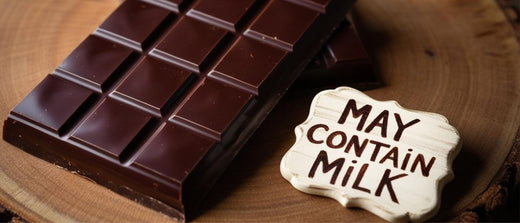Why Does Some Vegan Chocolate Say "May Contain Milk"?
Ever wondered why a vegan chocolate bar sometimes comes with a "may contain" notice for milk? It seems contradictory, doesn’t it? But the truth is, it’s more complicated than just leaving dairy out of the recipe.
Since the recent product recall by Tesco of LOVE RAW's product, I wanted to do a brief overview of why this happens, and why it’s more common than you might think.
-
Most Brands Don’t Make Their Own Chocolate
Many chocolate brands don’t actually make their own chocolate. They buy pre-made chocolate from large manufacturers (like Callebaut) and melt it down to create their products. If those suppliers also produce milk chocolate, there’s always a risk of cross-contamination. Even if the ingredients are vegan, the production environment might not be dairy-free. -
Contract Manufacturing Comes with Risks
A lot of brands outsource their production (and yes, also use pre-made chocolate) to co-manufacturers; factories that produce products for many different companies. If that facility also makes milk chocolate or can’t clean to a dairy-free standard, contamination can happen. This means even a fully plant-based recipe might need a "may contain" warning due to shared equipment or production spaces. -
Extra Cautious Suppliers
Sometimes, it’s not even about the production process; it’s about being cautious. Many suppliers haven’t invested in allergen testing to confirm their ingredients are completely dairy-free, and presents problems for producers, like us. For example, when we first started, our chocolate had zero dairy in the recipe, and was made in our dedicated dairy-free facility. But we couldn’t be 100% certain that what our ingredient suppliers were sending us was completely dairy-free. And unable to initially afford allergen testing, we had to include a "may contain milk" warning to protect against legal risks.
Now that we’ve completed our own allergen testing, we’re confident saying our chocolate is truly dairy-free. But before that, it was a case of better safe than sorry.
-
Vegan Doesn’t Always Mean Dairy-Free Production
Some brands market their products as vegan because they don’t add dairy to the recipe. But that doesn’t mean the chocolate was made in a dairy-free environment. Many brands just add oats or coconut to their usual production line and call it plant-based, without changing anything about how or where it’s made. If they still make milk chocolate on the same site, the risk of contamination is still there. -
The LoveRaw Recall: A Real-World Example
Recently, LoveRaw had to recall some of their products because contamination levels were higher than a standard "may contain" warning could cover. Understandably, vegan customers get frustrated. If it's a vegan chocolate, produced by a plant-based company, why is there milk in the products? Well, the answer is probably that LoveRaw is one of the many MANY companies that are a chocolate company, that don't actually make chocolate. They get someone else to do it for them (a contract manufacturer). And that company also makes the chocolate for lots of other companies, including those that use milk in their chocolate. And they had a process fail, likely a contamination event.
What Should Vegans Look For?
If you’re serious about avoiding dairy, it’s not enough to just check the ingredients. Ask brands about their production process. Do they make it themselves? Do they use a dedicated dairy-free facility? Do their suppliers allergen-test their ingredients? These details matter.
At The Undairy Co., we’re proud that in the coming months all our bars will be going out with the dairy-free labeling on them. We don't use dairy in our process, or our factory, so we will be dropping our 'may contain' notice very soon!


Share:
From Personal Craving to Public Craze: The Birth of Undairy Chocolate
We're Officially Dairy Free (& Gluten Free)